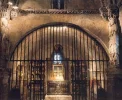sillydoll
Veteran Member
- Time of past OR future Camino
- 2002 CF: 2004 from Paris: 2006 VF: 2007 CF: 2009 Aragones, Ingles, Finisterre: 2011 X 2 on CF: 2013 'Caracoles': 2014 CF and Ingles 'Caracoles":2015 Logrono-Burgos (Hospitalero San Anton): 2016 La Douay to Aosta/San Gimignano to Rome:
In the middle ages, one of the most important pilgrim duties was to visit the various relics along the roads to Santiago.
The most bone tingling, goose-bump moment for me on the camino was gazing, awe-struck, at a relic - a piece of stained fabric the size of a dishcloth which has been preserved in a modest chamber in the cathedral in Oviedo for over 1300 years. History and scientific studies claim that this 84cm X 53cm piece of cloth was used to cover and clean the face of Jesus after his crucifixion. Together with the Shroud of Turin, it is the most tested Christian relic in the world. Its history is well documented and much more straightforward than that of the Shroud of Turin.
According to the 12th Century Book of the Testaments of Oviedo, and the Chronicon Regum Legionensium, until 614 the sudarium was in Palestine. When Jerusalem was attacked and conquered by the Persians it was taken in a 'Holy Ark' together with other precious relics, first to Alexandria, then across to North Africa, then into Spain, going first to Seville and then to Toledo with St Isidore where it stayed for 75 years. When the Arabs invaded Spain it was taken north to Oviedo. On 14th March 1075 the chest was officially opened in the presence of King Alfonso VI, his sister Doña Urraca, and Rodrigo Díaz de Vivar (el Cid). A list was made of the relics that were in the chest. These included fragments of the Cross, crumbs from the Last Supper, relics of the Virgin Mary and the Twelve Apostles and the sudarium, the cloth that had covered the face of Christ.
How does it compare with the Shroud of Turin?
Over the years many sophisticated, forensic experiments have been done on the fabric and on the blood, fluid, pollens and residues of myrrh and aloe. Scientific results show that:
"The blood on both the sudarium and the shroud belong to the same group, namely AB. The length of the nose through which the pleural oedema fluid came onto the sudarium is exactly the same length as the nose on the image of the shroud. When the shroud is placed over the stains on the sudarium the most obvious coincidence is the exact fit of the stains with the beard on the face. A small stain is also visible on the right hand side of the man's mouth. This stain is hardly visible on the shroud, but VP-8 and photo enhancements have confirmed its presence. The thorn wounds on the nape of the neck coincide perfectly with the bloodstains on the shroud. Polarized Image Overlay Techniques have been applied to the sudarium, comparing it to the image and bloodstains on the shroud. The frontal stains on the sudarium show seventy points of coincidence with the shroud, and the rear side shows fifty. The only possible conclusion is that the Oviedo sudarium covered the same face as the Turin Shroud."
Experts say that, "All the studies carried out so far point in one direction, with nothing to suggest the contrary, the sudarium was used to cover the head of the dead body of Jesus of Nazareth from when he was taken down from the cross until he was buried."
Goose-bump stuff indeed!
"Quien va a Santiago y no al Salvador, visita al criado y deja al Señor" says the old proverb. (Whoever goes to Saint James and not to the Saviour, visits the servant and misses the Master.)
Sil
The most bone tingling, goose-bump moment for me on the camino was gazing, awe-struck, at a relic - a piece of stained fabric the size of a dishcloth which has been preserved in a modest chamber in the cathedral in Oviedo for over 1300 years. History and scientific studies claim that this 84cm X 53cm piece of cloth was used to cover and clean the face of Jesus after his crucifixion. Together with the Shroud of Turin, it is the most tested Christian relic in the world. Its history is well documented and much more straightforward than that of the Shroud of Turin.
According to the 12th Century Book of the Testaments of Oviedo, and the Chronicon Regum Legionensium, until 614 the sudarium was in Palestine. When Jerusalem was attacked and conquered by the Persians it was taken in a 'Holy Ark' together with other precious relics, first to Alexandria, then across to North Africa, then into Spain, going first to Seville and then to Toledo with St Isidore where it stayed for 75 years. When the Arabs invaded Spain it was taken north to Oviedo. On 14th March 1075 the chest was officially opened in the presence of King Alfonso VI, his sister Doña Urraca, and Rodrigo Díaz de Vivar (el Cid). A list was made of the relics that were in the chest. These included fragments of the Cross, crumbs from the Last Supper, relics of the Virgin Mary and the Twelve Apostles and the sudarium, the cloth that had covered the face of Christ.
How does it compare with the Shroud of Turin?
Over the years many sophisticated, forensic experiments have been done on the fabric and on the blood, fluid, pollens and residues of myrrh and aloe. Scientific results show that:
"The blood on both the sudarium and the shroud belong to the same group, namely AB. The length of the nose through which the pleural oedema fluid came onto the sudarium is exactly the same length as the nose on the image of the shroud. When the shroud is placed over the stains on the sudarium the most obvious coincidence is the exact fit of the stains with the beard on the face. A small stain is also visible on the right hand side of the man's mouth. This stain is hardly visible on the shroud, but VP-8 and photo enhancements have confirmed its presence. The thorn wounds on the nape of the neck coincide perfectly with the bloodstains on the shroud. Polarized Image Overlay Techniques have been applied to the sudarium, comparing it to the image and bloodstains on the shroud. The frontal stains on the sudarium show seventy points of coincidence with the shroud, and the rear side shows fifty. The only possible conclusion is that the Oviedo sudarium covered the same face as the Turin Shroud."
Experts say that, "All the studies carried out so far point in one direction, with nothing to suggest the contrary, the sudarium was used to cover the head of the dead body of Jesus of Nazareth from when he was taken down from the cross until he was buried."
Goose-bump stuff indeed!
"Quien va a Santiago y no al Salvador, visita al criado y deja al Señor" says the old proverb. (Whoever goes to Saint James and not to the Saviour, visits the servant and misses the Master.)
Sil


















